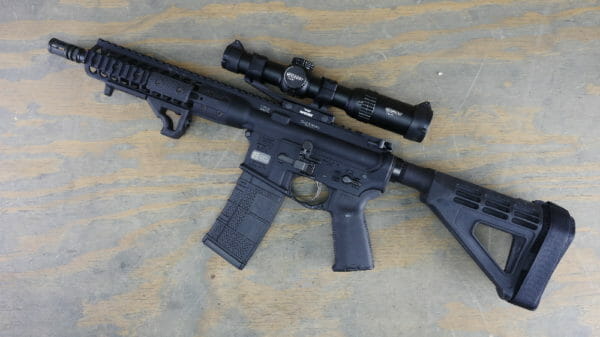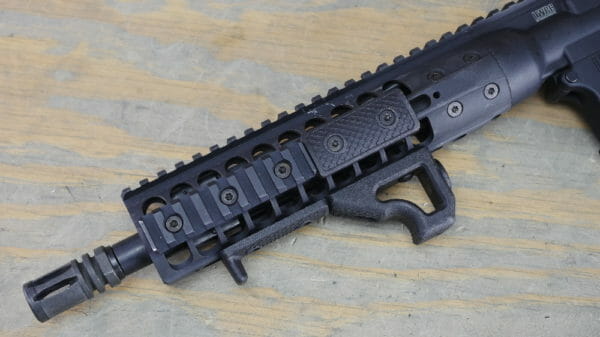
U.S.A. –-(Ammoland.com)- When space is at a premium and you want to pack an AR-15 you are limited to three options, get a tax stamp and go the SBR route, get your hands on one of LAW Tactical’s excellent folding adaptors, or the most common route of getting yourself an AR pistol from the get-go.
While an SBR might give you some advantages, the main drawback is traveling from one state to the next as well as adding $200 to the price of the gun right out of the gate. Now I am not one that really likes the idea of traveling without a firearm. When I fly, I always pack either my ATEi Glock 19, a Glock 43, or a Smith J Frame depending on the trip. But when I drive somewhere I have more space to work with and more importantly, no weight restrictions.
Normally when driving I would use my 14.5″ pinned & welded AR with a LAW Tactical folder, but since Duncan was going to be riding with me on the Brownells Convoy Across America he wanted an AR on board for himself. We were going to be passing through a ton of uninhabited highway as well as some rough areas where a couple of AR’s might not be a bad idea. Call me overly cautious, I’m OK with that. Since the pistol is not subject to NFA rules, we wouldn’t have to worry about filing paperwork to legally take it across state lines.
Optics
Let’s get the optics out of the way right outa the gate. Initially, I had the LWRCi pistol setup with an Aimpoint Comp M4 off my personal SBR but switched it out during the testing for a Vortex Strike Eagle 1-6 in a Warne mount.
While this isn’t a review of the optic but I do want to say that the Strike Eagle seemed to be ideal for the pistol. You can do quite a lot with an AR pistol, especially if you are using a low power variable optic.

Features
Since the lower is the heart of the rifle, that really is the best place to start talking about the LWRCi Pistol. It is interesting to note that the lower is laser engraved “pistol” on the magwell.
The ambi controls on the pistol are a welcome addition and alone nearly justify the premium the pistol commands over others that are comparable in quality. I particularly like the LMT inspired design of the bolt stop. While it is a bit hard to explain, the mechanism is very similar to the one LMT used on the MARS lowers.

The magazine release button is equally well thought out and located in the right place unlike other ambi lowers on the market. instead of lifting the mag catch like the LMT, the LWRCi mag release relies on a slightly more complex, but more elegant lever system.

So how is the trigger? While it is a touch smoother than most mil-spec triggers, it still hovers right around 5 1/4 pounds which is in line with most mil-spec triggers in terms of weight even though the trigger break is a bit cleaner.

The LWRCi pistol that we received for testing was not the M-LOK model which is fine, but know that M-LOK is always ideal in my opinion. LWRCi fitted a 10.5″ 1:7 twist hammer forged barrel to one of their proprietary Monoforge upper receivers. The barrel isn’t chrome lined but instead uses a NiCorr treatment on the barrel. If you are a fan of their rifles, you pretty much know exactly what to expect.

As mentioned, the rail is not the M-LOK variant that LWRCi offers but instead relies on threaded inserts and screws to attach covers or rail sections.

If you have a need to service the gas system you need to remove several screws that hold the handguard tight to the Monoforge upper and slide it off. I found it interesting that with all of the high-end components on the pistol that LWRCi decided to go with a standard A2 flash hider instead of something fancier.

Under the handguard, you will find a pistol length gas system with a nitride tube. When I inspected the gas block closer, I was pleased to find it pinned in place rather than using the set screws normally seen on low profile gas blocks.

In order to make the pistol more useable without requiring a tax stamp an SB Tactical brace is fitted over a KAK pistol receiver extension. LWRCi installed a carbine length spring and an H2 buffer as is the norm for 10.5″ barreled AR variants.

Something that I always look for when inspecting any AR-15 is how well the end plate is staked. While staking is a hotly debated topic, I personally believe it to be the best way of locking the buffer tube to the receiver. While thread lockers keep the castle nut from rotating on the tube, the stake prevents the tube and castle nut from rotating as one piece on the receiver.

LWRCi uses their keyless bolt carrier in the pistol which removes the possibility of the gas key coming loose under heavy firing schedules. According to the LWRCi website the BCG is made from a alloy used in Formula 1 race car transmissions and has several improvements over a mil-spec BCG. The redesigned extractor, bolt face, and locking lugs are some of the enhancements that I believe led to the rifle running so well during the high round count test we conducted.

Shooting Impressions
As you can see, between Duncan, me, and being used at a range get together during the Brownells Convoy, the LWRCi pistol saw north of a thousand rounds during the evaluation. We didn’t experience any malfunctions even though the pistol was not cleaned during the eval period. The pistol was even subjected to a rainstorm during a trip to the range and didn’t hiccup once. Even as dirty as the internal components were, not once was there a concern of reliability.
While I don’t have photos of the targets, accuracy was on par with what you would expect to see from a cold hammer forged 10.5″ barreled gun. Groups hovered just above the 1 MOA range with 77-grain OTM ammo, well within what I would consider acceptable from an AR pistol.
So how about the recoil impulse? I found the pistol to be slightly harder to shoot quickly than my 10.5″ AR-15 SBR. The largest reason for this was the amount of flex in the pistol brace, a necessary evil in the case of this pistol.
Final Thoughts
While a 10.5 AR-15 pistol might not be my first choice, I see little reason to not consider the LWRCi pistol if you are looking for a 10.5″ barreled AR. The ambi controls and keyless BCG really set this option apart from competing pistols.
The only thing that I feel would make the pistol better is the use of a barrel in the 11.5″ to 12.5″ barrel. Sure this is a touch longer than the norm, but the terminal ballistic advantage from that extra inch or two really are worth the sacrifice in overall length.
The LWRCi pistol with brace carries an MSRP of $1,683 but often has a street price hovering right around $1,500. Learn more on the LWRCi website.
About Patrick R.
Patrick is a firearms enthusiast that values the quest for not only the best possible gear setup but also pragmatic ways to improve his shooting skills across a wide range of disciplines. He values truthful, honest information above all else and had committed to cutting through marketing fluff to deliver the truth. You can find the rest of his work on FirearmRack.com as well as on the YouTube channel Firearm Rack or Instagram at @thepatrickroberts.
